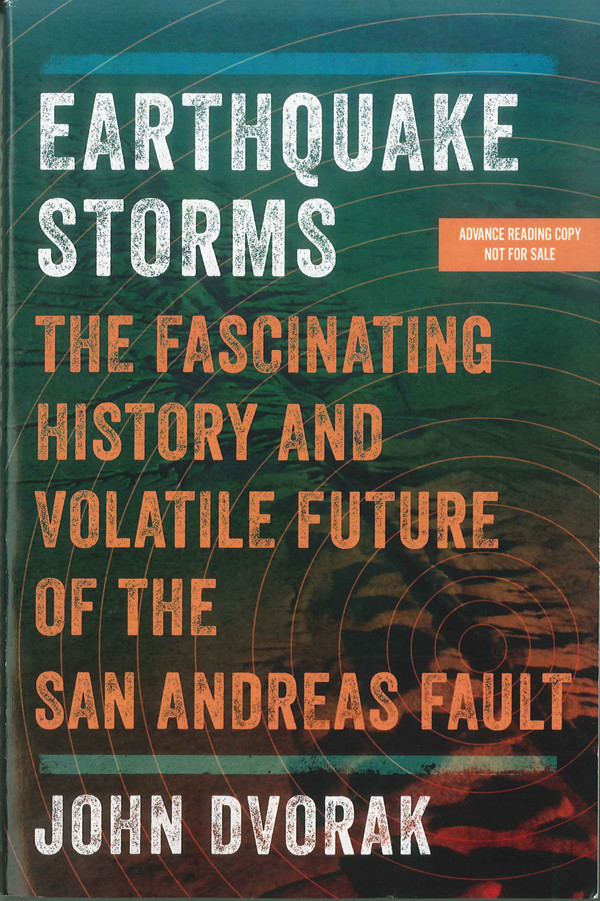
by Susan Hough Monday, July 28, 2014

"Earthquake Storms: The Fascinating History and Volatile Future of the San Andreas Fault," by John Dvorak, Pegasus, 2014, ISBN: 978-1605984957.
One of the most famous pictures of the San Andreas Fault — taken by G.K. Gilbert, the pioneering geologist whose late-19th century insights into faults and the earthquake cycle were close to prescient — shows a woman standing next to the ruptured fault immediately after the 1906 earthquake.
The photo is well known to most earth scientists, but not many of them have ever given more than fleeting thought to the identity of the Lady of the Fault. How did she come to be alongside the fault, and alongside G.K. Gilbert, at this pivotal moment in the annals of earthquake science? For that matter, how did G.K. Gilbert come to be in San Francisco at this time? As scientists, we see the science. Myopic to a fault (ahem), however, we often don’t think about the larger story.
The title of John Dvorak’s new book, “Earthquake Storms: The Fascinating History and Volatile Future of the San Andreas Fault,” suggests a book focused on the science. What do we know about the past activity of California’s most fearsome fault? What does this hard-won knowledge tell us about the question that is never far from every Californian’s mind: namely, “Is the Big One coming? And when?”
“Earthquake Storms” covers these issues, inevitably acknowledging the inability of modern science to provide the answers that people most badly want. But the treatment of the science is interwoven with, and sometimes eclipsed by, other sorts of stories. How did geologists first discover, and come to understand, the San Andreas Fault? Who were the scientists behind the science? Who was the Lady of the Fault? (Spoiler alert: It was Alice Eastwood, curator of botany at the California Academy of Sciences, who famously saved invaluable type-specimens from the 1906 fire.)
The public doesn’t likely wonder about the lives of famous earth scientists, at least in part because there aren’t many famous earth scientists. By virtue of developing the magnitude scale that came to bear his name, Charles Richter stands virtually alone in the popular vernacular, an earthquake scientist with global name recognition. Yet almost nothing was known about his life story, even among earthquake professionals, until not too many years back, when curiosity led me to his papers, preserved for posterity in the Caltech archives, which I then wrote about in my 2007 book, “Richter’s Scale: Measure of an Earthquake, Measure of a Man.” Regarding Richter’s story, Dvorak acknowledges that his book benefited greatly from mine, along with a handful of other books. Some of the stories in “Earthquake Storms” will thus be familiar to readers acquainted with the rather small genre of earthquake books written for a popular audience. But the familiar stories are woven together with new material to focus on the story of the San Andreas Fault, with heavy emphasis on the history and people as well as the science.
The real strength of “Earthquake Storms” is the clear and comprehensive treatment of geology as well as history. At least to this seismologically inclined reader, however, the book falls short on the fascinating seismology behind earthquake storms, or clusters, an idea that remains somewhat controversial.
Although there is a growing body of evidence that faults and fault systems experience relatively short periods of activity separated by long periods of dormancy, many key questions remain unanswered: What controls the timing of earthquake clusters? Do some faults tend to produce a domino chain of earthquakes while others do not? What are the implications for assessment of seismic hazard?
“Earthquake Storms” discusses only some of the science and evidence for clustering, including some from California, which experienced large or great earthquakes in 1812, 1857, 1872 and 1906 — not to mention big earthquakes on the nearby Hayward Fault in 1868 and the San Jacinto Fault in 1899.
And, storms or no storms, it is important to keep geological timescales in mind: 45 years elapsed between California’s 1812 and 1857 quakes and nearly 100 years separated the earthquakes of 1812 and 1906. This was no made-for-television apocalypse.
All readers bring their own perspectives to books, and my perspective as a research seismologist is likely different from that of the nonspecialist audience for whom this book is primarily written. My reservations notwithstanding, there is much to recommend “Earthquake Storms.” For the nonspecialist reader, it offers a clear and interesting treatment of earthquake science and, for earthquake scientists as well as nonscientists, it offers a fascinating up-close look at the often overlooked people and stories behind science. Lastly, the book leaves readers in California with a bottom line as sobering as it is unassailable: We might not know exactly what storms lie ahead, but during all of our lifetimes, we have only ever known the lull.
© 2008-2021. All rights reserved. Any copying, redistribution or retransmission of any of the contents of this service without the expressed written permission of the American Geosciences Institute is expressly prohibited. Click here for all copyright requests.